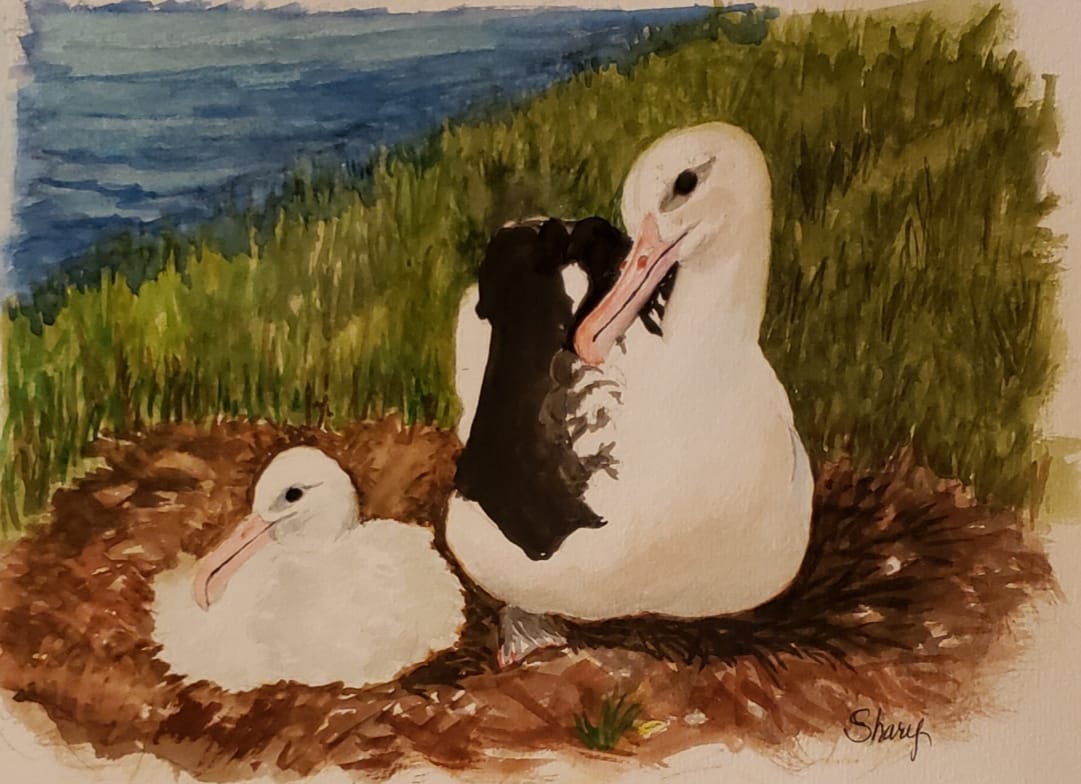
Northern Royal Albatross beside its chick, watercolour by Shary Weckwerth for ACAP
The Conservation Services Programme of New Zealand’s Department of Conservation works to reduce the impact of commercial fishing on protected species in New Zealand fisheries waters. At regular meetings of the CSP’s Technical Working Group (TWG), reports on ongoing projects are considered, many of which deal with aspects of the biology and conservation of ACAP-listed albatrosses and petrels. Two final reports tabled at last month’s meeting of the TWG dealt with counts of breeding Northern Royal Albatrosses Diomedea sanfordi (globally Endangered and nationally Naturally Uncommon) conducted in the Chatham Islands in 2020.
The reports’ overall summary follows:
“Aerial photographic surveys were carried out in September and December 2020 to provide estimates of the numbers of northern royal albatross (Diomedea sanfordi) fledglings and biennial breeding species nest on these islands, the other location being Taiaroa Head on the Otago Peninsula, Dunedin. The population has been assessed sporadically since the 1970s through a mix of ground counts of nesting birds and counts of adults from aerial photographs. Assessments of breeding success have been equally sporadic, typically involving aerial surveys carried out just before the chicks start fledging.
The 2020 trips were timed to coincide with fledging (September) and the start of incubation next breeding season (December). Because individuals breed biennially, two surveys are required to obtain the most accurate overall population estimate. The 3,994 pairs occupying nests in December 2020 (the start of the 2020/21 breeding season) can be added to the 2,043 pairs considered to have fledged a chick the previous year, derived from the September 2020 survey, to give an estimated current adult breeding population of 6,037 pairs. This is similar to the 5,908 pairs estimated by Bell et al. (2017) using the same method. This is ~37% lower than the average recorded in the late-1980s to mid-1990s and 24% lower than that estimated for the mid-1970s. The reasons for this are briefly discussed.
Northern giant petrels (Macronectes halli) were also counted in September 2020, just after the start of this species’ annual breeding season. The counts were highly uncertain: 1,799–2,251 individuals. Comparison of this count with previous ones are complicated by differences in their seasonal timing and difficulties of distinguishing individuals from their backgrounds. Overall, however, they suggest a broadly stable trend. The Chatham Islands populations constitute around 17.5 % of this species’ global population.
To enhance image quality and reduce uncertainty in image interpretation and therefore in future population estimates, several recommendations are made on amending survey features and procedures.”
References:
Frost, P.G.H. 2021a. Numbers of Northern Royal Albatross chicks on the Chatham Islands, September 2020. Whanganui: Science Support Services. 17 pp.
Frost, P.G.H. 2021b. Status of Northern Royal Albatross Diomedea sanfordi nesting on the Chatham Islands, December 2020. Whanganui: Science Support Services. 20 pp.
Access both reports from here.
John Cooper, ACAP Information Officer, 04 October 2021

 English
English  Français
Français  Español
Español